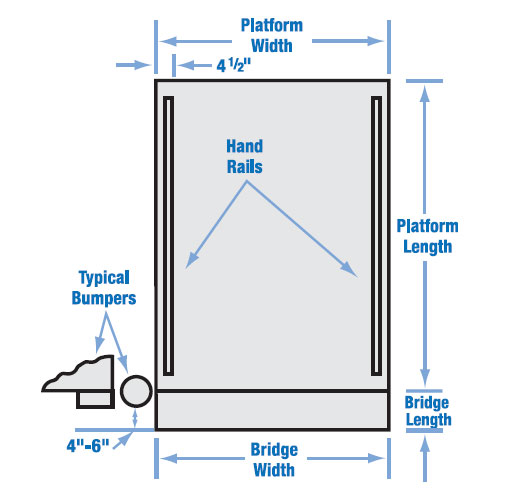Specifying a Safe Dock Lift
Selecting a Dock Lift
A number of factors must be considered when selecting an appropriate dock lift. These considerations include whether the equipment should be on top of the ground or a pit-mounted recessed lift; the appropriate platform size; lifting and axle rating capacities; power units and controls; bridges; and other options. All factors are important, but platform size and capacities are particularly critical because they directly impact the safety of operating the dock.
Top of the Ground Lifts
These units can be mounted on any flat concrete slab and require no pit work. If mounted on blacktop, they will sink during the summer. These models cannot be installed in pits because their lowered height does not permit the addition of the 8-in. bevel toe guards required by ANSI for pit-mounted lifts.
The advantages of not installing a pit include cost savings and avoiding drainage issues and potential interference with underground utilities. In addition, if the unit needs to be moved later, it is an easy matter to unbolt the unit and move it with no pit to fill in. Some units have been in continuous service for 35 years.
Top of ground units have ramps that transition loads from the platform to ground level which is no effort for off-loading operations, but can be tiring if heavy loads must be pushed up a ramp for loading onto a truck. Top of the ground units can offer easy dock to ground access if the approach ramps are shortened and the units mounted immediately adjacent to the dock.
For typical models, capacities range from 4,000 lb up to 15,000 lb and platform sizes range from 6 ft x 6 ft up to 8 ft x 12 ft.
The cost of top of ground units is always higher than recessed units. However, if the cost of pit construction is added to the equipment prices, top of ground units can be competitive.
Recessed or Pit-Mounted Lifts
Pit-mounted dock lifts are installed in a concrete pit in the ground or a pit on top of a raised concrete dock. They can also be installed on top of the ground, but they require a long approach ramp. Equipment costs are less expensive than top of ground lifts.
Their biggest advantage is that these units are mounted flush with surrounding surfaces so they do not present an obstacle to drive-over traffic. This is especially important if the unit is being mounted in a doorway. Recessed units offer level loading both at ground level and at truck height. If recessed units are mounted within the face of a dock, they can provide easy dock to ground access. As noted above, if the approach ramps are shortened and units are mounted immediately adjacent to the dock, top of the ground units can offer the same easy dock to ground access.
Standard capacities for typical models of recessed units range up to 20,000 lb. The general rule of thumb for estimating the cost to install a pit-mounted dock lift is to add 50 percent to the price of the lift. This covers the cost of the pit, electrical work, mechanical installation, freight and taxes. If a lift costs $10,000.00, the total cost for everything would be about $15,000.00, including the lift.

Drawing courtesy of Advance Lifts®
Anatomy of a dock lift.
Platform Size
The platform size is primarily determined by the type of transport equipment that will be used to load or unload trucks. Undersized platforms with not enough space for the operator can create an unsafe situation.
Platform width: Equals the width of the widest load plus 12 in. minimum for operating clearance including hand rails.
* The minimum suggested platform width is 6 ft.
* Guardrails use about 8 in. of useable platform width on most models.
* There should be at least 4 in. of clearance on each side of the widest load, such as a 48-in.-wide pallet, for ease of maneuvering.
* In some cases the loads may be wider and some users prefer to unload two pallets side by side (the most popular wooden pallet is 40 in. wide so that two can be put in a truck side by side). In these cases, 7-ft and 8-ft-wide platforms should be specified.
* Cushion tire fork trucks to 8,000-lb capacity are generally less than 48 in. wide.
* Pneumatic tire fork trucks to 8,000-lb capacity are generally less than 60 in. wide.
Platform length: Equals the length of the longest load plus the length of any material handling equipment which may project beyond the load plus room for the operator, if one is required.
*If the loads are four-wheeled carts or baskets, or the loading equipment is limited to two-wheeled hand carts, a 6-ft platform length is sufficient.
• Although a 7-ft-long platform is the minimum requirement for loads transferred via manual pallet jacks, an 8-ft-long platform is highly recommended and is the industry standard.
• Powered pallet jacks work best with 10-ft lengths in order to comfortably fit the load, powered pallet jacks and operator all in line.
• A 12-ft length should be used for loads transferred via sit-down rider fork trucks since they are much longer.
• Powered pallet jacks, or straddle stackers, that are powered by battery or electric motor also fit well on 10-ft-long platforms.
The sizes mentioned above cover almost all applications and are mostly available as typical standard offerings in both top of ground and recessed styles of lifts. Unusual loads may require custom designed units with platform widths of 10 ft or 12 ft and platform lengths of up to 65 ft. Examples of unusual loads include large-sized artwork for museums and air cargo containers. If a client has special requirements, design professionals are advised to consult with a full-service supplier.









